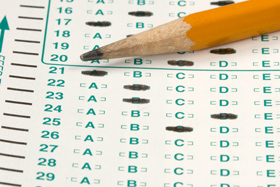ABA committee wants to end use of alternative law school admission tests

Image from Shutterstock.
An ABA committee is recommending the elimination of a rule that allows most law schools to admit up to 10 percent of their entering classes with students who haven’t taken the Law School Admission Test.
Barring that, the committee is proposing to make the rule applicable to all schools.
The rule, approved last year by the governing council of the ABA Section of Legal Education and Admissions to the Bar, currently applies only to students enrolled in undergraduate programs at the same university as the law school and/or students pursuing another degree in addition to their JD.
Applicants admitted under the rule must have scored in the top 85th percentile nationally on one of four standardized college or graduate admissions tests and must either have ranked in the top 10 percent of their undergraduate class or achieved a cumulative GPA of 3.5 or better through six semesters of academic work.
The rule was adopted at the request of the section’s accreditation committee to provide a safe harbor and clear guidance to schools that want to use undergraduate admission tests such as the ACT or the SAT or graduate-level admission tests such as the GMAT or GRE as alternatives to the LSAT. It came after 16 schools had been granted variances from the requirement that all applicants must take a test that is valid and reliable in assessing an applicant’s capability of satisfactorily completing the school’s program of legal education. To date, only the LSAT has demonstrated such reliability.
But members of the section’s Standards Review Committee, which met Friday and Saturday in Chicago, are concerned that none of the alternative admissions tests have been shown to be valid and reliable predictors of law school performance.
So they voted to recommend that the council either do away with the rule altogether or amend it in a way that would make it available to all law schools.
“If the experience of 16 schools with variances was sufficient to justify the creation of an alternative admission program that does not require an LSAT for some applicants, that alternative should be available to all law schools, including law schools that are not affiliated with a university,” the committee said in an explanation of the reasoning behind its proposed recommendation.
If the council agrees to do away with the rule, the committee has asked the council to stipulate that in order for a test to be deemed valid and reliable for use in law school admissions, it must be validated as such by the testing agency that administers it.
If the council decides to keep the rule, the committee has asked it to require schools to report a student’s LSAT score if the student took the LSAT or report the score of any alternative admission test upon which a student was admitted. It also wants the council to require schools to file periodic reports measuring the performance of students admitted under any alternative admission test. And it wants the council to order a review of the rule after three years to determine whether it should be amended or repealed.
At its meeting Friday, the committee also voted to recommend:
• Giving law schools the option of granting academic credit to students for participating in field placement programs for which they receive compensation—but only if the school is able to demonstrate that it has maintained sufficient control of the student experience.
• Adding gender identity and the phrase “or any other characteristic not relevant to the applicant’s capability to satisfactorily complete the school’s program of legal education” to the list of groups that a school may not discriminate against.
• Removing the list of groups now covered under the diversity and inclusion standard—race, gender and ethnicity—from the standard itself and focusing instead on the broader purpose of the standard, which is to promote cross-cultural understanding, help break down stereotypes and enable students to understand people from different backgrounds.
Under the committee’s proposal, law schools would be required to provide an environment in which diversity and inclusion are welcomed and embraced, and to demonstrate their commitment to diversity and inclusion through concrete action.
The list of groups to be covered by the standard would be spelled out in an interpretation and would include without limitation race, color, religion, national origin, gender, gender identity, sexual orientation, age and disability.
All of the committee’s recommendations will go to the council for consideration at its meeting next month in Minneapolis. If the council agrees with the proposed changes, they will be posted for notice and comment and be the subject of a public hearing in mid-July. If the council adopts the proposed changes at its July meeting in Chicago, they could be reviewed by the House of Delegates at the ABA Annual Meeting in August. The House can either concur with the changes or refer them back to the council for further consideration, but the council has the final say on any changes in the standards.



